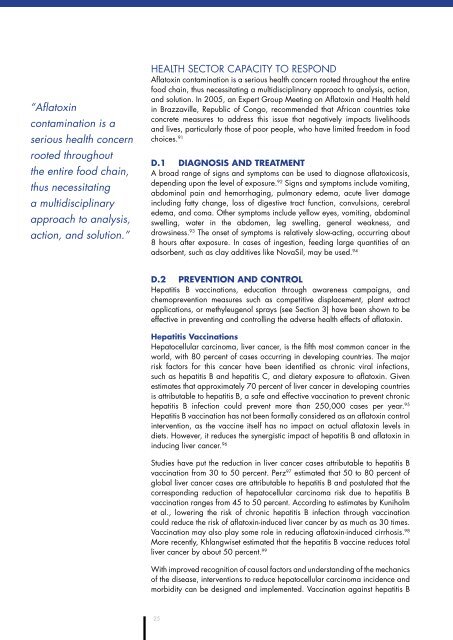Aflatoxin: A Synthesis of the Research in Health, Agriculture and Trade
Aflatoxin: A Synthesis of the Research in Health, Agriculture and Trade
Aflatoxin: A Synthesis of the Research in Health, Agriculture and Trade
Create successful ePaper yourself
Turn your PDF publications into a flip-book with our unique Google optimized e-Paper software.
“<strong>Aflatox<strong>in</strong></strong><br />
contam<strong>in</strong>ation is a<br />
serious health concern<br />
rooted throughout<br />
<strong>the</strong> entire food cha<strong>in</strong>,<br />
thus necessitat<strong>in</strong>g<br />
a multidiscipl<strong>in</strong>ary<br />
approach to analysis,<br />
action, <strong>and</strong> solution.”<br />
heAlth SectoR cAPAcity to ReSPonD<br />
<strong>Aflatox<strong>in</strong></strong> contam<strong>in</strong>ation is a serious health concern rooted throughout <strong>the</strong> entire<br />
food cha<strong>in</strong>, thus necessitat<strong>in</strong>g a multidiscipl<strong>in</strong>ary approach to analysis, action,<br />
<strong>and</strong> solution. <strong>in</strong> 2005, an expert Group Meet<strong>in</strong>g on <strong>Aflatox<strong>in</strong></strong> <strong>and</strong> health held<br />
<strong>in</strong> Brazzaville, Republic <strong>of</strong> congo, recommended that African countries take<br />
concrete measures to address this issue that negatively impacts livelihoods<br />
<strong>and</strong> lives, particularly those <strong>of</strong> poor people, who have limited freedom <strong>in</strong> food<br />
choices. 91<br />
d.1 diAGnoSiS And treAtMent<br />
A broad range <strong>of</strong> signs <strong>and</strong> symptoms can be used to diagnose aflatoxicosis,<br />
depend<strong>in</strong>g upon <strong>the</strong> level <strong>of</strong> exposure. 92 Signs <strong>and</strong> symptoms <strong>in</strong>clude vomit<strong>in</strong>g,<br />
abdom<strong>in</strong>al pa<strong>in</strong> <strong>and</strong> hemorrhag<strong>in</strong>g, pulmonary edema, acute liver damage<br />
<strong>in</strong>clud<strong>in</strong>g fatty change, loss <strong>of</strong> digestive tract function, convulsions, cerebral<br />
edema, <strong>and</strong> coma. o<strong>the</strong>r symptoms <strong>in</strong>clude yellow eyes, vomit<strong>in</strong>g, abdom<strong>in</strong>al<br />
swell<strong>in</strong>g, water <strong>in</strong> <strong>the</strong> abdomen, leg swell<strong>in</strong>g, general weakness, <strong>and</strong><br />
drows<strong>in</strong>ess. 93 <strong>the</strong> onset <strong>of</strong> symptoms is relatively slow-act<strong>in</strong>g, occurr<strong>in</strong>g about<br />
8 hours after exposure. <strong>in</strong> cases <strong>of</strong> <strong>in</strong>gestion, feed<strong>in</strong>g large quantities <strong>of</strong> an<br />
adsorbent, such as clay additives like novaSil, may be used. 94<br />
d.2 Prevention And control<br />
hepatitis B vacc<strong>in</strong>ations, education through awareness campaigns, <strong>and</strong><br />
chemoprevention measures such as competitive displacement, plant extract<br />
applications, or methyleugenol sprays (see Section 3) have been shown to be<br />
effective <strong>in</strong> prevent<strong>in</strong>g <strong>and</strong> controll<strong>in</strong>g <strong>the</strong> adverse health effects <strong>of</strong> aflatox<strong>in</strong>.<br />
Hepatitis vacc<strong>in</strong>ations<br />
hepatocellular carc<strong>in</strong>oma, liver cancer, is <strong>the</strong> fifth most common cancer <strong>in</strong> <strong>the</strong><br />
world, with 80 percent <strong>of</strong> cases occurr<strong>in</strong>g <strong>in</strong> develop<strong>in</strong>g countries. <strong>the</strong> major<br />
risk factors for this cancer have been identified as chronic viral <strong>in</strong>fections,<br />
such as hepatitis B <strong>and</strong> hepatitis c, <strong>and</strong> dietary exposure to aflatox<strong>in</strong>. Given<br />
estimates that approximately 70 percent <strong>of</strong> liver cancer <strong>in</strong> develop<strong>in</strong>g countries<br />
is attributable to hepatitis B, a safe <strong>and</strong> effective vacc<strong>in</strong>ation to prevent chronic<br />
hepatitis B <strong>in</strong>fection could prevent more than 250,000 cases per year. 95<br />
hepatitis B vacc<strong>in</strong>ation has not been formally considered as an aflatox<strong>in</strong> control<br />
<strong>in</strong>tervention, as <strong>the</strong> vacc<strong>in</strong>e itself has no impact on actual aflatox<strong>in</strong> levels <strong>in</strong><br />
diets. however, it reduces <strong>the</strong> synergistic impact <strong>of</strong> hepatitis B <strong>and</strong> aflatox<strong>in</strong> <strong>in</strong><br />
<strong>in</strong>duc<strong>in</strong>g liver cancer. 96<br />
Studies have put <strong>the</strong> reduction <strong>in</strong> liver cancer cases attributable to hepatitis B<br />
vacc<strong>in</strong>ation from 30 to 50 percent. Perz 97 estimated that 50 to 80 percent <strong>of</strong><br />
global liver cancer cases are attributable to hepatitis B <strong>and</strong> postulated that <strong>the</strong><br />
correspond<strong>in</strong>g reduction <strong>of</strong> hepatocellular carc<strong>in</strong>oma risk due to hepatitis B<br />
vacc<strong>in</strong>ation ranges from 45 to 50 percent. Accord<strong>in</strong>g to estimates by Kuniholm<br />
et al., lower<strong>in</strong>g <strong>the</strong> risk <strong>of</strong> chronic hepatitis B <strong>in</strong>fection through vacc<strong>in</strong>ation<br />
could reduce <strong>the</strong> risk <strong>of</strong> aflatox<strong>in</strong>-<strong>in</strong>duced liver cancer by as much as 30 times.<br />
Vacc<strong>in</strong>ation may also play some role <strong>in</strong> reduc<strong>in</strong>g aflatox<strong>in</strong>-<strong>in</strong>duced cirrhosis. 98<br />
More recently, Khlangwiset estimated that <strong>the</strong> hepatitis B vacc<strong>in</strong>e reduces total<br />
liver cancer by about 50 percent. 99<br />
With improved recognition <strong>of</strong> causal factors <strong>and</strong> underst<strong>and</strong><strong>in</strong>g <strong>of</strong> <strong>the</strong> mechanics<br />
<strong>of</strong> <strong>the</strong> disease, <strong>in</strong>terventions to reduce hepatocellular carc<strong>in</strong>oma <strong>in</strong>cidence <strong>and</strong><br />
morbidity can be designed <strong>and</strong> implemented. Vacc<strong>in</strong>ation aga<strong>in</strong>st hepatitis B<br />
25


